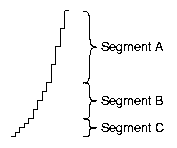
Each of these encoding schemes is designed in a roughly logarithmic fashion. Lower signal values are encoded using more bits; higher signal values require fewer bits. This ensures that low amplitude signals will be well represented, while maintaining enough range to encode high amplitudes.
The actual encoding doesn't use logarithmic functions, however. The input range is broken into segments, each segment using a different interval between decision values. Most segments contain 16 intervals, and the interval size doubles from segment to segment. The illustration shows three segments with four intervals in each.

Both encodings are symmetrical around zero. mu-law uses 8 segments of 16 intervals each in each of the positive and negative directions, starting with a interval size of 2 in segment 1, and increasing to an interval size of 256 in segment 8. A-law uses 7 segments. The smallest segment, using an interval of 2, is twice the size of the others (32 intervals). The remaining six segments are "normal", with 16 intervals each, increasing up to an interval size of 128 in segment 7. Thus, A-law is skewed towards representing smaller signals with greater fidelity.